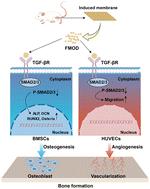当前位置:
X-MOL 学术
›
Biomater. Sci.
›
论文详情
Our official English website, www.x-mol.net, welcomes your feedback! (Note: you will need to create a separate account there.)
Fibromodulin facilitates the osteogenic effect of Masquelet's induced membrane by inhibiting the TGF-β/SMAD signaling pathway
Biomaterials Science ( IF 6.6 ) Pub Date : 2024-03-01 , DOI: 10.1039/d3bm01665j Kai Wang 1, 2 , Ming Zhou 1, 2 , Yuanshu Zhang 1 , Yesheng Jin 2 , Yuan Xue 1 , Dong Mao 3 , Yongjun Rui 1
Biomaterials Science ( IF 6.6 ) Pub Date : 2024-03-01 , DOI: 10.1039/d3bm01665j Kai Wang 1, 2 , Ming Zhou 1, 2 , Yuanshu Zhang 1 , Yesheng Jin 2 , Yuan Xue 1 , Dong Mao 3 , Yongjun Rui 1
Affiliation

|
Masquelet's induced membrane (IM) technique is a promising treatment strategy for the repair of substantial bone defects. The formation of an IM around polymethylmethacrylate bone cement plays a crucial role in this technique. Several studies have indicated that IMs have bioactivity because they contain abundant blood vessels, a variety of cells, and biological factors. The bioactivity of an IM increases during the initial stages of formation, thereby facilitating bone regeneration and remodeling. Nevertheless, the precise mechanisms underlying the enhancement of IM bioactivity and the promotion of bone regeneration necessitate further investigation. In this study, we successfully developed a Masquelet IM model of critical femur defects in rats. By employing proteomics analysis and biological detection techniques, we identified fibromodulin (FMOD) as a pivotal factor contributing to angiogenesis and the enhanced bioactivity of the IM. A significant increase in angiogenesis and the expression of bioactive factors in the IM was also observed with the upregulation of FMOD expression. Furthermore, this effect is mediated through the inhibition of the transforming growth factor beta (TGF-β)/SMAD signaling pathway. We also demonstrated that administering recombinant human FMOD enhanced osteogenesis in rat bone marrow mesenchymal stem cells and angiogenesis in human umbilical vein endothelial cells in vitro. Furthermore, the negative regulatory effect of the TGF-β signaling pathway was verified. In conclusion, this study provides a novel theoretical basis for the application of IMs in bone-defect reconstruction and explores possible new mechanisms that may play an important role in promoting the bioactivity and osteogenic potential of IMs.
中文翻译:

纤维调节蛋白通过抑制 TGF-β/SMAD 信号通路促进 Masquelet 诱导膜的成骨作用
Masquelet 的诱导膜 (IM) 技术是修复大量骨缺损的一种有前途的治疗策略。聚甲基丙烯酸甲酯骨水泥周围IM的形成在该技术中起着至关重要的作用。多项研究表明IMs具有生物活性,因为它们含有丰富的血管、多种细胞和生物因子。IM 的生物活性在形成的初始阶段增加,从而促进骨再生和重塑。然而,增强IM生物活性和促进骨再生的确切机制还需要进一步研究。在这项研究中,我们成功开发了大鼠股骨严重缺损的 Masquelet IM 模型。通过采用蛋白质组学分析和生物检测技术,我们确定纤维调节蛋白(FMOD)是促进血管生成和增强 IM 生物活性的关键因素。随着 FMOD 表达的上调,还观察到 IM 中血管生成和生物活性因子表达的显着增加。此外,这种效应是通过抑制转化生长因子β (TGF-β)/SMAD 信号通路介导的。我们还证明,体外施用重组人 FMOD 可增强大鼠骨髓间充质干细胞的成骨作用和人脐静脉内皮细胞的血管生成作用。此外,还验证了TGF-β信号通路的负调节作用。总之,本研究为IMs在骨缺损重建中的应用提供了新的理论基础,并探索了可能在促进IMs的生物活性和成骨潜力方面发挥重要作用的新机制。
更新日期:2024-03-01
中文翻译:

纤维调节蛋白通过抑制 TGF-β/SMAD 信号通路促进 Masquelet 诱导膜的成骨作用
Masquelet 的诱导膜 (IM) 技术是修复大量骨缺损的一种有前途的治疗策略。聚甲基丙烯酸甲酯骨水泥周围IM的形成在该技术中起着至关重要的作用。多项研究表明IMs具有生物活性,因为它们含有丰富的血管、多种细胞和生物因子。IM 的生物活性在形成的初始阶段增加,从而促进骨再生和重塑。然而,增强IM生物活性和促进骨再生的确切机制还需要进一步研究。在这项研究中,我们成功开发了大鼠股骨严重缺损的 Masquelet IM 模型。通过采用蛋白质组学分析和生物检测技术,我们确定纤维调节蛋白(FMOD)是促进血管生成和增强 IM 生物活性的关键因素。随着 FMOD 表达的上调,还观察到 IM 中血管生成和生物活性因子表达的显着增加。此外,这种效应是通过抑制转化生长因子β (TGF-β)/SMAD 信号通路介导的。我们还证明,体外施用重组人 FMOD 可增强大鼠骨髓间充质干细胞的成骨作用和人脐静脉内皮细胞的血管生成作用。此外,还验证了TGF-β信号通路的负调节作用。总之,本研究为IMs在骨缺损重建中的应用提供了新的理论基础,并探索了可能在促进IMs的生物活性和成骨潜力方面发挥重要作用的新机制。



























 京公网安备 11010802027423号
京公网安备 11010802027423号